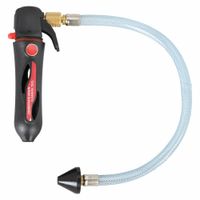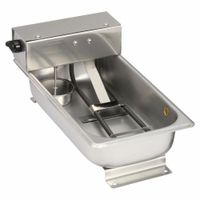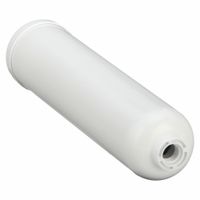Call +(254) 703 030 000 / 751 483 999 / 721 704 777
- Home
- Hvac And Refrigeration
- Hvac Installation Repair Mounting Equipment
- Condensate Management
.....Read More
Frequently Asked Questions
What are the best products for cleaning and maintaining condensate drain pans?
The best products for cleaning and maintaining condensate drain pans include:
1. **Algaecide Tablets**: These tablets prevent algae, mold, and mildew growth in the drain pan. They dissolve slowly, providing long-term protection. Brands like Pan-Treat or Nu-Calgon offer effective options.
2. **Condensate Pan Cleaners**: Liquid cleaners specifically designed for condensate pans can dissolve sludge and prevent clogs. Products like RectorSeal’s Condensate Pan Cleaner are popular for their effectiveness.
3. **Vinegar**: A natural and cost-effective option, vinegar can be used to clean and disinfect the pan. Pour a mixture of vinegar and water into the pan to remove buildup and prevent odors.
4. **Bleach Solution**: A diluted bleach solution can be used to sanitize the pan and kill bacteria. However, it should be used sparingly to avoid corrosion.
5. **Foaming Coil Cleaners**: These cleaners can be sprayed onto the coils and pan to remove dirt and debris. They help maintain the efficiency of the HVAC system. Brands like Frost King and AC-Safe offer reliable products.
6. **Wet/Dry Vacuum**: For physical removal of debris and water, a wet/dry vacuum can be used to clean the pan thoroughly.
7. **Pipe Cleaners or Brushes**: These tools can help manually remove clogs and buildup in the drain line and pan.
8. **Drain Pan Treatment Strips**: These strips are placed in the pan to prevent clogs and odors. They slowly release chemicals that keep the pan clean.
Regular maintenance using these products can prevent water damage and ensure the efficient operation of HVAC systems. Always follow manufacturer instructions and safety guidelines when using chemical cleaners.
How do condensate neutralizers work and why are they important?
Condensate neutralizers are devices used to treat acidic condensate produced by high-efficiency condensing appliances like furnaces, boilers, and water heaters. These appliances extract additional heat from exhaust gases, causing water vapor to condense and form acidic liquid condensate, primarily containing carbonic acid, with traces of sulfuric and nitric acids.
The neutralizer works by raising the pH level of this acidic condensate to a neutral level before it is discharged into the drainage system. It typically consists of a container filled with a neutralizing media, such as limestone (calcium carbonate) or magnesium oxide. As the acidic condensate flows through the neutralizer, it reacts with the media, undergoing a chemical reaction that increases the pH level, effectively neutralizing the acidity.
The importance of condensate neutralizers lies in their ability to prevent damage to plumbing systems and the environment. Acidic condensate can corrode metal pipes, leading to leaks and costly repairs. It can also harm municipal sewer systems and negatively impact aquatic life if discharged untreated. By neutralizing the acidity, these devices protect infrastructure and reduce environmental impact.
Additionally, some local building codes and regulations require the use of condensate neutralizers for high-efficiency appliances to ensure compliance with environmental standards. Regular maintenance, including checking and replacing the neutralizing media, is essential to ensure the neutralizer functions effectively over time.
What are the signs of a clogged condensate drain and how can it be cleared?
Signs of a clogged condensate drain include:
1. **Water Leaks**: Puddles of water around the indoor unit or water stains on walls or ceilings.
2. **Musty Odors**: Mold or mildew growth due to excess moisture.
3. **Increased Humidity**: Higher indoor humidity levels than usual.
4. **AC Shutdown**: Some systems have a safety switch that turns off the AC to prevent water damage.
5. **Poor Cooling Performance**: Reduced efficiency in cooling.
6. **Water Damage**: Visible damage to surrounding areas.
To clear a clogged condensate drain:
1. **Turn Off the AC**: Ensure the system is off to prevent further damage.
2. **Locate the Drain Line**: Typically a PVC pipe near the indoor unit.
3. **Use a Wet/Dry Vacuum**: Attach it to the drain line's end outside the house to suck out the clog.
4. **Flush with Vinegar or Bleach**: Pour a solution of vinegar or diluted bleach into the drain line to kill mold and algae.
5. **Use a Stiff Brush or Wire**: Gently push through the line to dislodge the clog.
6. **Check the Drain Pan**: Remove any standing water and clean the pan.
7. **Inspect the Drain Line**: Ensure it is free of debris and properly sloped.
8. **Professional Help**: If the clog persists, contact a professional HVAC technician.
Regular maintenance, such as cleaning the drain line every few months, can prevent future clogs.
How often should condensate pans be cleaned and treated?
Condensate pans should be cleaned and treated at least once a year as part of regular HVAC maintenance. However, in environments with high humidity or where the HVAC system is in constant use, such as in commercial buildings or in regions with hot climates, it may be necessary to clean and treat the pans more frequently, such as every three to six months. Regular cleaning helps prevent the buildup of algae, mold, and bacteria, which can lead to clogs, water overflow, and unpleasant odors.
During cleaning, the pan should be inspected for any signs of damage or corrosion. If any issues are found, they should be addressed immediately to prevent leaks or further damage. Treatment typically involves using a biocide or algaecide to inhibit the growth of microorganisms.
In addition to regular cleaning and treatment, it's important to ensure that the condensate drain line is clear and functioning properly. This can be done by flushing the line with a solution of water and vinegar or a commercial cleaning agent to remove any blockages.
Overall, the frequency of cleaning and treating condensate pans depends on the specific conditions and usage of the HVAC system, but regular maintenance is crucial to ensure efficient operation and to prevent potential issues.
What are the benefits of using condensate evaporator pans?
Condensate evaporator pans offer several benefits, particularly in refrigeration and HVAC systems:
1. **Energy Efficiency**: These pans utilize the heat generated by the appliance to evaporate condensate water, reducing the need for additional energy consumption. This contributes to overall energy savings and lowers operational costs.
2. **Space Saving**: By eliminating the need for external drainage systems, condensate evaporator pans save space. This is particularly beneficial in compact or built-in appliances where space is limited.
3. **Ease of Installation**: Without the requirement for complex plumbing or drainage systems, installation is simplified. This reduces installation time and costs, making it a convenient option for both manufacturers and consumers.
4. **Maintenance Reduction**: These pans require minimal maintenance compared to traditional drainage systems. They are designed to handle the condensate efficiently, reducing the risk of clogs and leaks.
5. **Versatility**: Condensate evaporator pans can be used in a variety of appliances, including refrigerators, freezers, and air conditioning units. This versatility makes them a practical choice for different applications.
6. **Environmental Benefits**: By reducing water waste and energy consumption, condensate evaporator pans contribute to environmental sustainability. They help in minimizing the carbon footprint of appliances.
7. **Improved Hygiene**: By efficiently evaporating condensate, these pans help prevent the growth of mold and bacteria that can occur in stagnant water, thus maintaining a more hygienic environment.
8. **Cost-Effectiveness**: The reduced need for additional components and maintenance leads to cost savings over the lifespan of the appliance.
Overall, condensate evaporator pans provide a practical, efficient, and environmentally friendly solution for managing condensate in various appliances.
How can I prevent mold and mildew in my HVAC condensate system?
To prevent mold and mildew in your HVAC condensate system, follow these steps:
1. **Regular Maintenance**: Schedule regular inspections and maintenance of your HVAC system to ensure it is functioning properly. This includes checking the condensate drain line and pan for blockages or leaks.
2. **Clean the Drain Line**: Use a mixture of vinegar and water or a commercial cleaner to flush the condensate drain line every few months. This helps remove any buildup that could lead to mold growth.
3. **Install a Float Switch**: A float switch can shut off the HVAC system if the condensate pan overflows, preventing water accumulation that can lead to mold.
4. **Use UV Lights**: Install UV lights in the HVAC system to kill mold spores and bacteria. These lights can be placed near the evaporator coil to prevent mold growth.
5. **Ensure Proper Insulation**: Insulate ducts and pipes to prevent condensation, which can contribute to mold growth. Proper insulation also helps maintain the efficiency of the HVAC system.
6. **Maintain Humidity Levels**: Use a dehumidifier to keep indoor humidity levels between 30-50%. Mold thrives in high humidity, so controlling moisture is crucial.
7. **Check and Replace Filters**: Regularly check and replace air filters to ensure proper airflow and reduce the risk of mold spores circulating through the system.
8. **Seal Leaks**: Inspect and seal any leaks in the ductwork to prevent moisture from entering and creating a breeding ground for mold.
9. **Use Mold Inhibitors**: Consider using mold inhibitors in the condensate pan to prevent mold and mildew growth.
10. **Monitor for Signs of Mold**: Regularly inspect the system for any signs of mold or mildew, such as musty odors or visible growth, and address issues promptly.
What are the common causes of condensate drain clogs and how can they be prevented?
Common causes of condensate drain clogs include:
1. **Algae and Mold Growth**: Warm, moist environments in drain lines promote algae and mold growth, leading to blockages.
2. **Dust and Debris**: Dust, dirt, and debris can accumulate in the drain pan and line, causing clogs.
3. **Rust and Corrosion**: Metal components can rust, and the resulting particles can obstruct the drain.
4. **Improper Installation**: Incorrectly installed drain lines can lead to poor drainage and clogs.
5. **Frozen Evaporator Coils**: When coils freeze and thaw, excess water can overwhelm the drain system, leading to clogs.
6. **Broken or Disconnected Drain Line**: Physical damage or disconnection can cause water to back up.
Prevention methods include:
1. **Regular Maintenance**: Schedule routine HVAC maintenance to inspect and clean the condensate drain line.
2. **Use of Algaecide Tablets**: Place algaecide tablets in the drain pan to prevent algae and mold growth.
3. **Install a Float Switch**: A float switch can shut off the system if the drain pan overflows, preventing water damage.
4. **Clean the Drain Line**: Use a wet/dry vacuum or a plumber’s snake to clear the line periodically.
5. **Ensure Proper Installation**: Verify that the drain line is correctly installed with the proper slope for effective drainage.
6. **Insulate Evaporator Coils**: Proper insulation can prevent coils from freezing and causing excess water.
7. **Check for Leaks and Damage**: Regularly inspect the drain line for any signs of leaks or physical damage.
By addressing these causes and implementing preventive measures, you can maintain an efficient condensate drainage system and avoid clogs.




